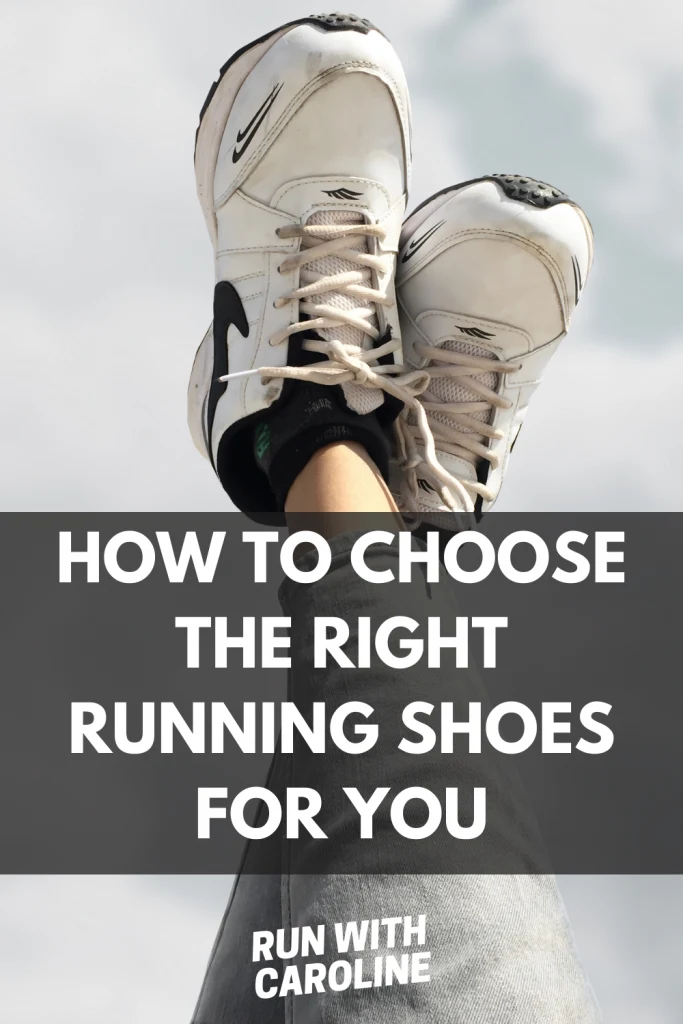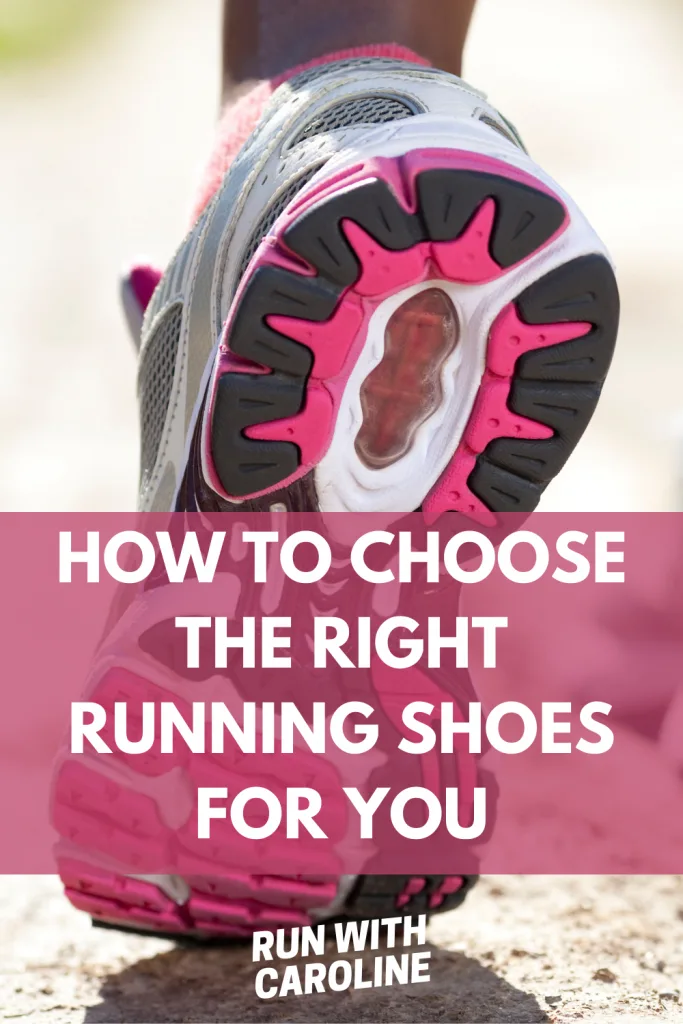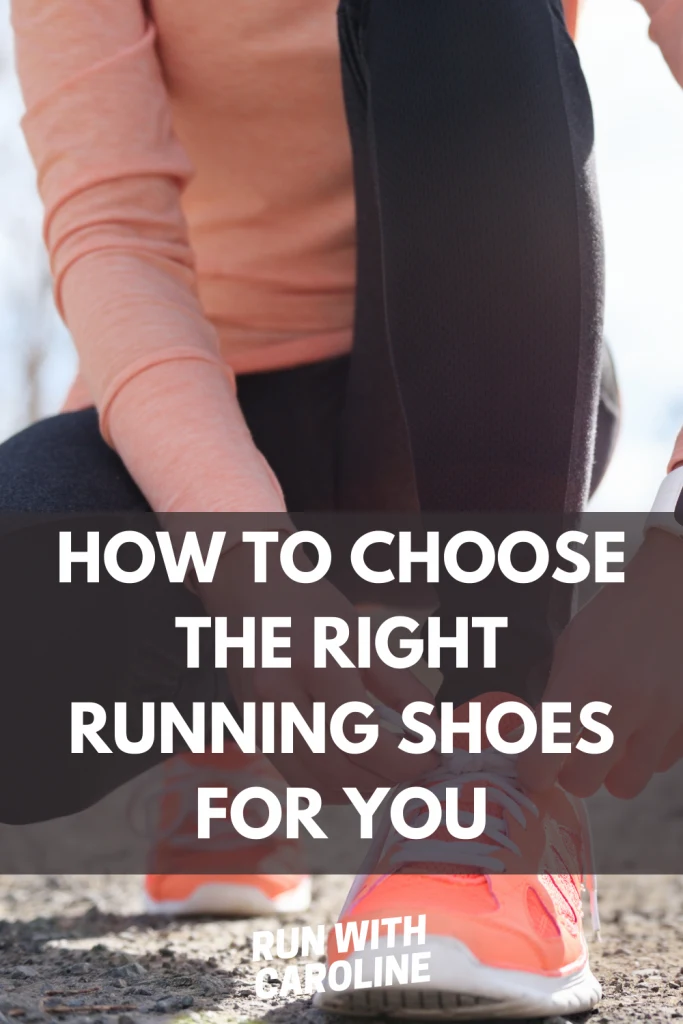Knowing how to find the right running shoes can be tricky. Luckily there are some simple tips that you can follow to help you pick the perfect pair.
You may be at the stage where you have to pick your first pair of proper running shoes. Maybe you’ve recently started running, or you’ve signed up for your first half marathon?
Whatever your reasons, choosing your first pair of running shoes can be daunting.
There are lots of things to think about and if you don’t do your research, you risk buying a pair that do not fit or do not support your feet in the right way.
But how do you find the right running shoes? What do you need to look out for?
In this guide we’ll explore:
- Do I need running shoes?
- How should running shoes fit?
- What type of running shoes do I need?
- How do I determine my running gait?
- What are the three types of running shoes?
- Where to buy running shoes?
- How to find the right running shoes?
- How much should I spend on running shoes?
- How long do running shoes last?
- 6 tips on how to find the right running shoes for you
Ready?
Let’s go!

Do I need running shoes?
Yes! If you run regularly, it’s crucial you find the right pair of running shoes.
Running shoes have two key functions:
- Absorb the shock when your foot lands on the ground (this is called cushioning).
- Encourage your feet to move in a safe and efficient manner through running gait.
Research has shown that a whopping 4 out of 5 runners wear running shoes that don’t suit their running style.
In a 2014 study, 95 recreational runners between the ages of 19 and 71 were interviewed to understand their beliefs when it comes to risk factors for running injuries.
During the interview process, the most cited factor was “wearing the wrong shoes”, along with “not stretching,” “excess of training,” “not warming up,” and “lack of strength,”.
The good news is running shoe technology has come a long way over the last few decades.
Running shoes nowadays are designed to improve your comfort on runs and reduce the risk of common running injuries.
Related: The best recovery shoes for runners: Oofos slides vs Hoka slides
How should running shoes fit?
The truth is finding the right running shoes that fit all depends on a number of factors that are unique to you and how you run.
There is no one size fits all approach when it comes to running shoes.
A well-fitting pair of running shoes will help to:
- Support your feet when you run
- Provide flexibility and durability
- Protect against common running injuries like shin splints
- Cushion your feet from heavy landings
- Improve your performance
Related: Can you put shoes in the dryer? 7 running shoe cleaning do’s and don’ts
What type of running shoes do I need?
When you find the right running shoes, it’s important to determine your foot arch type and running gait as both of these elements will determine the right pair of running shoes for you.
- Your foot arch is the area between your heel and the ball of your foot.
- Your running gait is how your feet behave when you run.
Foot arch
Your foot arch will impact how you run (your running gait) and the amount of impact forces that are placed on the base of your foot when you run.
There are three different types of foot arches: normal, high and low.
If you are unsure what your foot arch type is, then the easiest way to check is looking at an imprint of your foot.
You can do this by wetting both feet and standing on a paper bag for about 10 seconds.
Once you step off the bag, look at the imprint of your foot made on the bag.
Here’s what to look out for in order to identify your foot arch type:
- Normal foot arch. If the middle portion of your footprint is about halfway filled, with a curve along the arch, this means you have normal foot arches.
- High foot arch. If the only part of your footprint shown is your heel, the ball of your foot and your toes, this means you have high foot arches.
- Low foot arch. If your footprint looks like a complete foot and it is totally filled in without much of an inward curve in the centre, you like have low foot arches (also known as flat feet.
Running gait
Now you understand your foot arch type, you can use this information to determine your running gait.
Your gait is how your feet behave when you run.
Running gait is really important when it comes to choosing running shoes as each running shoe is designed to accommodate certain gait types.
Here are the four types of gait:
- Severe overpronation. This is when your heel hits the ground first and then rolls inward excessively. This is normally because your ankle cannot stabilise your body properly. This is typically seen in runners with flat feet (low arches). The best type of shoe for an overpronator is a motion control shoe.
- Mild overpronation. This is when the outside of your heel hits the ground first and then rolls inward slightly, absorbing the shock. This is typically seen in runners with a low to medium arch. The best type of shoe for an mild overpronator is a stability shoe.
- Neutral. This is when the middle part of the heel hits the ground first and then the foot rolls inward slightly, absorbing the shock. This is typically seen in runners with a medium arch. The best type of shoe for a neutral runner is a neutral cushioning shoe.
- Underpronation (supination). This is when the outside of your heel hits the ground first and then stays on the outside of your foot through the entire footstrike. This is typically seen in runners with high arches. The best type of shoe for underpronators is a neutral cushioning shoe.
Related: 4 ways to improve running cadence

How do I determine my running gait?
The best way to determine your running gait is to do a gait analysis.
A gait analysis (or gait assessment) is the process used to determine the best pair of running shoes for you.
It will also help you find out what type of pronator you are and crucially what level of support you might need from a running shoe.
Many running shoe stores nowadays offer free gait analysis services using a treadmill.
The store will take you through all the necessary steps involved in a gait analysis and, combined with your running goals and running experience, will offer shoe recommendations based on the results of the gait assessment.
It’s worth noting that your running posture, running cadence and rhythm will also be taken into consideration when deciding the best running shoes for you.
Related: The best Brooks trail running shoes: Brooks Cascadia 13 review
What are the three types of running shoes?
Once you have understood your foot arch type and your running gait, you are ready to find the right running shoes.
As mentioned above, there are different types of running shoes that have been designed to support your feet in various ways.
Here are the three main types of running shoes:
#1 Motion control running shoes
Q: What are motion control running shoes?
Motion control shoes are designed for flat footed runners who overpronate. They have a wide and straight shape to them.
This type of shoe will prevent your foot from rolling in too far. It will also give your foot maximum support and the most control.
Q: Who needs motion control running shoes?
A: You should consider investing in motion control running shoes if:
- You have flat feet
- You overpronate (i.e. your foot rolls inwards)
#2 Stability running shoes
Q: What are stability running shoes?
A: If you have a normal foot arch and pronate only slightly, then this is the shoe for you.
Stability running shoes have a semi-curved shape to them and offer a good balance between cushioning and support.
Q: Who needs stability running shoes?
A: Consider investing in a pair of stability running shoes if:
- You have a normal foot arch
- You overpronate slightly (i.e. your foot rolls inwards slightly)
- You’d prefer a balance between cushioning and support
#3 Neutral cushioning running shoes
Q: What are neutral cushioning running shoes?
Neutral cushioning running shoes are designed for runners that have a high arched foot and who underpronate (supinate).
Cushioned shoes absorb the impact that your foot does not naturally absorb. They also have the most curved shape to them.
Q: Who needs neutral cushioning running shoes?
A: Consider buying a pair of neutral cushioning running shoes if:
- You have a high foot arch
- You underpronate (i.e. your foot rolls outwards)
- You prefer a cushioned shoe
Related: 4 simple tips to improve running form

Where to buy running shoes
Hopefully by now you have some idea of the type of running shoe you are looking for. Here comes the fun part – buying some running shoes!
Head to your local running shoe store, preferably one that offers a free gait analysis service.
This is because you are more likely to get the best support and advice you need when buying running shoes.
In other words, the staff are more likely to be trained on how to suggest the right running shoes for you.
In order to help you find the best shoe for you, go armed with answers to the following questions:
- How long have you been running?
- What shoes have you run in in the past? Do you like running in them?
- Where do you do most of your running?
- How many miles a week do you run on average?
- Are you training for a race?
- Are you aware of any foot problems?
You might also consider taking your old running shoes with you to the store.
This is because they can sometimes tell from your shoes how you run (e.g. one side of the shoe may be more worn than the other
Related: 7 of the best websites to buy affordable running clothes

How to find the right running shoes
Now it’s time for the fun part – trying on the shoes! This is one of the most important steps when it comes to buying the right running shoes.
It’s easy to get carried away during this process and simply choose running shoes that look the most stylish.
I get it – we all have our preferences when it comes to brands, colours and styles. However, when it comes to running shoes, substance is much more important than style.
After all, there’s no use buying a pair of running shoes that look amazing but fit poorly.
There are three factors to consider when finding the right running shoes:
- Is there enough room at the end of the shoe? A good general rule of thumb is to have about a thumb’s width between the top of your toe and the end of the shoe.
- Is there enough room either side of your foot? You will want enough room for your foot to spread out to allow for swelling when you run, especially during the summer months.
- Is there any slipping in the heel? You won’t want too much room at the back of the shoe.
It goes without saying but make sure you wear socks when you try on the shoes.
Most running shoe stores will also get you to run on a treadmill in your shoes so you can test them out in store to make sure they fit correctly.
Don’t be scared of this process – it has not been designed to catch you out!
The salesperson will simply watch you run on a treadmill for roughly 10-30 seconds so they can get more of an idea of how you run in the shoes.
They may also film it and play it back to you (with your permission, of course).
Related: How to run on a treadmill without falling
How much should I spend on running shoes?
A good quality pair of running shoes will set you back between £80 to £120.
One of the ways to save money when buying running shoes is to opt for the previous year’s model. These are normally priced 25% to 40% less than the latest model.
Related: The best running shoes: Brooks Adrenaline GTS 19 running shoe review
How long do running shoes last?
Once you’ve bought the right pair of running shoes, it’s time to start wearing them!
Whether or not you plan to run every other day in them, it’s important to note that running shoes have a shelf life.
A pair of good quality running shoes will last between 300 and 500 miles. This is about 4 to 6 months if you run roughly 20 miles per week.
You can also tell if you need a new pair of running shoes if:
- You start to experience new aches and pains.
- The tread on your running shoes looks worn out.
- The midsole feels tough.
- Your feet feel sore after a run.
Related: Heel pain after running: Causes + 8 ways to prevent it

6 tips on how to find the right running shoes for you
Now you know more about the importance of a proper pair of running shoes, here are some more tips on how to find the right running shoes.
#1 Go for a test run
Brands like Brooks offer a 90-day guarantee on their shoes which is great if you’d like a bit of time to test out your shoes.
#2 Opt for comfort over style
A shoe may look fashionable, but the fit and feel of it on your foot is what matters. Don’t compromise fit over style, you’ll soon regret it on that long run.
#3 Haggle a discount
A proper pair of running shoes can set you back between £80-£140.
If you’re on a budget, some running shoe stores offer discounts to run leaders and run coaches.
If you show them your UK Athletics license, you may be able to get some money off so try it and see.
#4 Don’t buy new shoes just before a race
As a general rule of thumb, wear your shoes in for a good fw months before wearing them during a race.
#5 Use a running shoe finder tool
Websites like Wiggle offer a running shoe finder tool 2021 to help narrow down the right running shoe for you.
#6 Complete a which running shoe is best for me quiz
Websites like the Running Shoe Guru offer quizzes to help you find the right running shoes for you.
Other useful resources
- Molly from All About Marathon Training has written an excellent post on running tips for beginners.
- 5 things I wish I’d known before returning to running - March 3, 2024
- Running 20 minutes a day: Benefits + how to start - January 27, 2024
- How to run your first 2 hour half marathon - January 16, 2024

Madison Rossow
Thursday 30th of December 2021
Thanks for sharing this interesting information I never expect this from you. Keep going